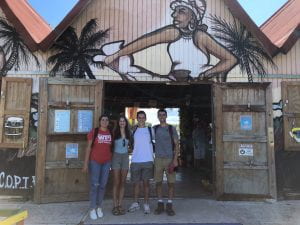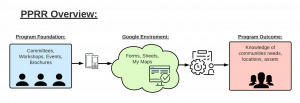Piñones Preparación Respuesta Recuperación
Sponsoring Organization: La Corporación Piñones Se Integra
Mission: To raise awareness and preparedness for times of emergency.
Puerto Rico is an island full of fabulous foods, cultures, and experiences which has made it a tourist destination for many. Unfortunately, Puerto Rico also faces various economic crises that have led to population declines, healthcare disparities, and the decline of education amongst young citizens (Borgen Project).
One community that feels neglected and isolated is Piñones, Loíza, PR. This feeling stems from the two-lane road that serves as the only way in and out of the community and is practically and symbolically what connects and divides Piñones from the rest of the island. Furthering this sense of isolation and neglect is the lack of attention the Piñones community receives after and during natural disasters. In the past, the community has been left to rebuild and support itself time and time again. These issues stem from systematic and institutional racism due to the fact that Piñones has a significantly higher African population than the rest of Puerto Rico (Colón, García, González…). Thus, the government falls short during emergencies and provides an insufficient number of resources to the community, making any distribution of these resources extremely difficult.
In order to combat these everyday challenges, for the first time, students from WPI worked collaboratively in Piñones with Maricruz Clemente Rivera who fou nded the organization, La Corporación Piñones Se Integra; COPI. COPI is a non-profit organization whose mission is to “find alternatives to the existing social problems that deteriorate Piñones in order to improve the quality of life of residents, families, and visitors” (COPI). In past natural disasters, COPI has been a central resource for the residents of Piñones, where they have collected and distributed supplies and necessities for the community. However, in the past COPI has not had the capacity to distribute supplies to every household due to an absence of knowledge of who needs what, and a preparedness to manage distribution in a crisis. Thus, eve when some relief resources were available, they had no efficient way to allocate these resources.
nded the organization, La Corporación Piñones Se Integra; COPI. COPI is a non-profit organization whose mission is to “find alternatives to the existing social problems that deteriorate Piñones in order to improve the quality of life of residents, families, and visitors” (COPI). In past natural disasters, COPI has been a central resource for the residents of Piñones, where they have collected and distributed supplies and necessities for the community. However, in the past COPI has not had the capacity to distribute supplies to every household due to an absence of knowledge of who needs what, and a preparedness to manage distribution in a crisis. Thus, eve when some relief resources were available, they had no efficient way to allocate these resources.
The main outcome of this project was creating the program Piñones Preparación Respuesta Recuperación (PPRR). The team collaborated with sponsors, co-researchers, and the community to create the foundation of an emergency preparedness program for the community of Piñones. The PPRR program focuses on community preparedness for natural disasters using networking and community collaboration. As seen in the figure below, the network of individuals participating in the program is explained.
The program is set up to discover community assets and resources for use in times of need. Through individuals’ community efforts, information collection, and community togetherness, the community response time in emergencies will be lessened. This response time relates to resource distribution, checking in on members of the community, and recovery efforts. The relationship between the different aspects of the program is depicted in the diagram below.
Findings and Methods:
Create Emergency Response Program Foundation:
The PPRR program is designed to create a network throughout Piñones that will work to engage the community to emphasize emergency awareness. Refer to the attached manual for a more in-depth explanation of each branch of the program. After establishing an administrative body of the network, information will be uploaded to a database based on individuals’ status within the program. This database offers a way for the administrative body of the program to access and organize data to best serve the community. Information on how data was collected and reported into Google Sheets can be found in the attached manual and report. In order for this program foundation to be left behind and easily modified for future use, the team decided to use Google Environment based platforms.
Discover Ways for Future Data Collection Within the Community:
Alongside creating the working PPRR program, the team set out to collect example data that can be implemented into the programs database. While in Piñones the team discovered the advantages and disadvantages of collecting data within the community. The team found that the most beneficial way of individual information collection is going door to door with an electronic and paper version of a form.
Work With Sponsors and Co-Researchers on Using System Technology:
To leave the program’s foundation behind, sponsors and co-researchers needed to be able to understand how to work each system. Several days were set aside to sit down with the sponsors and co-researchers and show them how to work the program. The team went through the system step by step and left behind a working manual that explains each part of the program’s software.
Design System User Manual for Sponsors and Future WPI Initiatives:
With the program functional, the team worked to complete a handbook that will guide others to complete their own mapping initiatives. This type of handbook is beneficial to others who are looking to complete similar projects for community networks. It included a technical aspect that shows a step-by-step process of how to use every part of the system and how to modify it for the project’s sponsors.
Conclusions:
Based on the community findings, the team concluded that people within the community feel that an emergency plan and overall emergency awareness is needed. A crucial part of the community that was key to creating a working program was the churches, who hold a large influence on the Piñones community. These churches should be the first organizations future project’s reach out to. It is also important to note that information gathered for such an important use of emergency preparedness can be extremely sensitive and the security of this information must be taken seriously.
Based on the technological system findings, the team concluded that finding a balance between functionality and ease of use is important. Overall, when considering ease of use, the Google Environment was the easiest environment to leave behind (Google Sheets, Docs and My Maps). When needing to leave behind a system of different technological pieces, such as databases and maps, it was also found that a user’s manual is extremely helpful for explaining how the system works.
When creating the PPRR program sponsors and co-researchers helped the team become fully immersed within the community. This brought new and exciting aspects toward the project when working on the program. The program is expected to continue and be built upon in future projects by anyone who wants to contribute toward preparing the community of Piñones for times of emergency.
Recommendations:
Recommendations for Collecting Data in the Community
- Use Google Forms when collecting data that needs to be uploaded into a system: The use of google forms is quick and easily accessible through a smartphone or computer. The data is easily stored and displayed, based on users’ preferences.
- Either go door to door, have a community event, or interact among known locals to gather data. When walking around neighborhoods it is very unlikely that people will be outside on the streets, which can cause delays in data collection.
Recommendations for Developing Mapping Capabilities
- Use “blocks” or areas to map individuals, not exact addresses or locations: Since many houses and buildings in Piñones do not have exact addresses, the actual mapping of an area would be better done in “blocks” or outlines.
Recommendations for User Manual
- Have step by step process for how to use Google Sheets and Google Forms: Having a step-by-step explanation in the manual for google sheets and forms will close any gaps or questions that the project leads have with the google database.
- Make sure to cite appropriate references: It is important to cite any sources or references used during the development of the manual to give proper credit and allow users to find further information.
Recommendations Regarding Creating a Database
- Link Google Forms to a Google Sheets: This helps with organization and automatic updates from google forms to an organized database.
- Manually enter coordinates or addresses into map: Google My Maps can only automatically input exact addresses from google forms. In areas without exact addresses, individuals will need to manually enter coordinates to pinpoint specific places on a map.
Recommendations for WPI
- Research possibility of other IQP groups continuing the data collection side of the project: The database is ready for data entry so another WPI project could potentially be adding data to the system and covering more ground in the actual resource side of the database.





